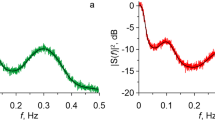Abstract
Beat-to-beat cardiovascular signals, e.g. a series of systolic pressure values, can be considered as time series which are pulse amplitude modulated (PAM) and pulse frequency modulated (PFM). The latter process, due to variations in heart rate, causes the series to become non-uniformly spaced in time. If PAM is to be quantified by spectral analysis, the influence of PFM must be known. An analytical expression is therefore derived for the spectrum of sinusoids which are sampled according to the output event series of a linear integral pulse frequency modulator (IPFM). We conclude that two spectral components arise at the difference and sum of the PFM and PAM frequencies, fp±fx, with amplitudes proportional to the PFM modulation depth. These components appear as a DC component and as a first harmonic if both modulating frequencies are equal. In addition, a cluster of spectral components appears around the mean pulse frequency fo (i.e. mean heart rate), at frequencies fo-nfp±fx, which may leak into the signal band. From these theoretical considerations, we conclude that the amplitude spectrum of a sinusoidally varying systolic blood pressure series can contain up to 20–30% spurious components, owing to the heart rate modulation process.
Similar content being viewed by others
References
Abel, F. L., andWaldhausen, J. A. (1969): ‘Respiratory and cardiac effects on venous return,’Am. Heart J.,78, p. 266
Abramowitz, M., andStegum, I. A. (1970): ‘Handbook of mathematical functions’ (Dover, New York)
Akselrod, S., Gordon, D., Madwed, J. B., Snidman, N. C., Shannon, D. C., andCohen, R. J. (1985): ‘Hemodynamic regulation: investigation by spectral analysis,’Am. J. Physiol.,249, pp. H867-H875
Almasi, J. A., andSchmitt, O. H. (1974): ‘Basic technology of voluntary cardiorespiratory synchronization in electrophysiology,’IEEE Trans.,BME-21, pp. 264–273
Baselli, G., Cerutti, S., Civardi, S., Liberati, D., Lombardi, F., Malliani, A., andPagani, M. (1986): ‘Spectral and cross-spectral analysis of heart rate and arterial blood pressure variability signals,’Comp. Biomed. Res.,19, pp. 520–534
Bayly, E. J. (1968): ‘Spectral analysis of pulse frequency modulation in the nervous systems,’IEEE Trans.,BME-15, pp. 257–265
Berger, R. D., Akselrod, S., Gordon, D., andCohen, R. J. (1986): ‘An efficient algorithm for spectral analysis of heart rate variability,’ —Ibid.,BME-33, pp. 900–904
Brigham, E. O. (1988): ‘The fast Fourier transform and its applications,’ (Prentice-Hall International)
Calvagno, G., andMunson, D. C., Jr, (1990): ‘New results on Yen’s approach to interpolation from nonuniformly spaced samples.’ Proc. IEEE Int. Conf. on Acoustics, Speech and Signal Processing, pp. 1535–1538
DeBoer, R. W., Karemaker, J. M., andStrackee, J. (1984): ‘Comparing spectra of a series of point events particularly for heart rate variability data,’IEEE Trans.,BME-31, pp. 384–387
DeBoer, R. W., andKaremaker, J. M. (1985): ‘Relationships between short-term blood-pressure flucturations and heart-rate variability in resting subjects I: a spectral analysis approach,’Med. Biol. Eng. Comput.,23, pp. 352–358
Faes, Th. J. C., Lanting, P., TenVoorde, B. J., andRompelman, O. (1990): ‘The origin of respiratory sinus arrhythmia: towards a closed-loop identification of autonomic regulation in the cardiovascular system using respiratory induced fluctuations in heart rate and arterial blood pressure,’Automedica,13, pp. 33–44
Gaster, M., andRoberts, J. B. (1977): ‘The spectral analysis of randomly sampled records by a direct transform,’Proc. R. Soc. Lond.,354, pp. 27–58
Hildebrandt, G. (1953): ‘Über die rhytmische Funktionsordnung von Puls and Atem,’Z. Klin. Med.,150, pp. 445–454
Hyndman, B. W., andMohn, R. K. (1975): ‘A model of the cardiac pacemaker and its use in decoding the information content of cardiac intervals,’Automedica,1, pp. 239–252
Jenq, Y. C. (1988): ‘Digital spectra of non-uniformly sampled signals: Fundamentals and high-speed waveform digitizers,’IEEE Trans.,BME-37, pp. 245–251
Kitney, R. I., andRompelman, O. (1987): ‘Beat-by-beat interrelationships between heart rate, blood pressure and respiration’in Kitney, R. I. andRompelman, O. (Eds.): ‘The beat-by-beat investigation of cardiovascular function’ (Clarendon Press, Oxford), pp. 146–177
Nyquist, H. (1928): ‘Certain topics in telegraph transmission theory,’AIEE Trans., pp. 617–644
Oppenheim, A. V., andWillsky, A. S. (1983): ‘Signals and systems,’ (Prentice Hall, Englewood Cliffs, New Jersey)
Pagani, M., Lombardi, F., Guzetti, S., Rimoldi, O., Furlan, R., Pizzinelli, P.,et al., (1986): ‘Power spectral analysis of heart rate and arterial pressure variabilities as a marker of sympatho-vagal interaction in man and conscious dogs,’Circ. Res.,59, pp. 178–193
Papoulis, A. (1977): ‘Generalized sampling expansion,’IEEE Trans.,CAS-24, pp. 652–654
Rompelman, O., Coenen, A. J. R. M., andKitney, R. I. (1977): ‘Measurement of heart-rate variability: Part 1 Comparative study of heart-rate variability analysis methods,’Med. Biol. Eng. Comput.,15, pp. 233–239
Rompelman, O. (1986): ‘Tutorial review on prcessing the cardiac event series: a signal analysis approach,’Automedica,7, pp. 191–212
Shannon, C. E. (1949): ‘Communication in the presence of noise,’Proc. IRE,37, pp. 10–21
Shapiro, H. S., andSilverman, R. A. (1960): ‘Alias-free sampling of random noise,’J. Soc. Ind. Appl. Math.,8, pp. 225–248
TenVoorde, B. J., Ree, E. F., Hack, W. W. M., Bergschneider, V. M., Hoekstra, B. P. T., Faes, Th. J. C., andRompelman, O. (1990): ‘Spectral quantification of respiratory sinus arrhythmia in preterm and fullterm neonates: beyond half the mean heart rate,’Automedica,13, pp. 15–31
TenVoorde, B. J., Faes, Th. J. C., andRompelman, O. (1994): ‘Spectra of data sampled at frequency modulated rates in application to cardiovascular signals: Part 2 evaluation of Fourier transform algorithms,’Med. Biol. Eng. Comput.,32 (1), pp. 71–76
Yen, J. L. (1956): ‘On nonuniform sampling of bandwidthlimited signals,’IRE Trans. Circuit Theory,CT-3, pp. 251–257
Author information
Authors and Affiliations
Rights and permissions
About this article
Cite this article
TenVoorde, B.J., Faes, T.J.C. & Rompelman, O. Spectra of data sampled at frequency-modulated rates in application to cardiovascular signals: Part 1 analytical derivation of the spectra. Med. Biol. Eng. Comput. 32, 63–70 (1994). https://doi.org/10.1007/BF02512480
Received:
Accepted:
Issue Date:
DOI: https://doi.org/10.1007/BF02512480




